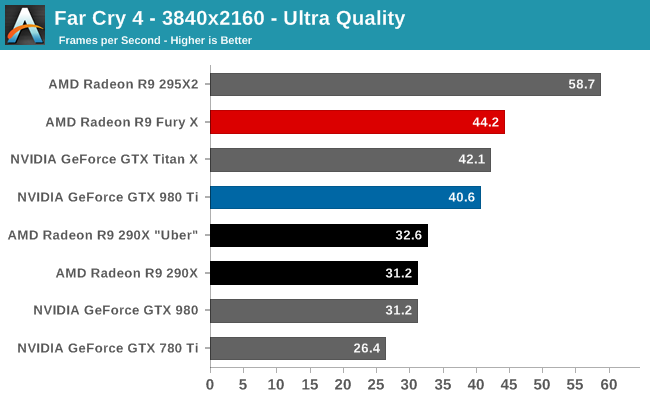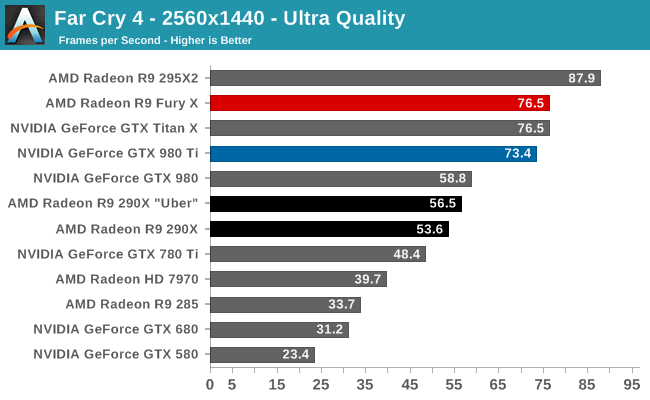The AMD Radeon R9 Fury X Review: Aiming For the Top
by Ryan Smith on July 2, 2015 11:15 AM ESTFar Cry 4
The next game in our 2015 GPU benchmark suite is Far Cry 4, Ubisoft’s Himalayan action game. A lot like Crysis 3, Far Cry 4 can be quite tough on GPUs, especially with Ultra settings thanks to the game’s expansive environments.



Like the Talos Principle, this is another game that treats AMD well. The R9 Fury X doesn’t just beat the GTX 980 Ti at 4K Ultra, but it beats the GTX Titan X as well. Even 1440p Ultra isn’t too shabby, with a smaller gap but none the less the same outcome.
Overall what we find is that the R9 Fury X has a 9% lead at 4K Ultra, and a 4% lead at 1440p Ultra, making this one of the only games where AMD takes the lead at 1440p. However something interesting happens if we run at 4K with lower quality settings, and that lead evaporates very quickly, shifting to an NVIDIA lead by roughly the same amount. At this time I don’t have a good explanation for this other than to say that whatever is going on at Ultra, it clearly is very different from what happens at Medium quality, and it favors AMD.
Finally, the performance gains over the R9 290X are around average. At 4K and 1440p Ultra the R9 Fury X picks up 35%; at 4K Medium that shrinks to 30%.










458 Comments
View All Comments
bennyg - Saturday, July 4, 2015 - link
Marketing performance. Exactly.Except efficiency was not good enough across the generations of 28nm GCN in an era where efficiency + thermal/power limits constrain performance, and look what Nvidia did over a similar era from Fermi (which was at market when GCN 1.0 was released) to Kepler to Maxwell. Plus efficiency is kind of the ultimate marketing buzzword in all areas of tech and not having any ability to mention it (plus having generally inferor products) hamstrung their marketing all along
xenol - Monday, July 6, 2015 - link
Efficiency is important because of three things:1. If your TDP is through the rough, you'll have issues with your cooling setup. Any time you introduce a bigger cooling setup because your cards run that hot, you're going to be mocked for it and people are going to be weary of it. With 22nm or 20nm nowhere in sight for GPUs, efficiency had to be a priority, otherwise you're going to ship cards that take up three slots or ship with water coolers.
2. You also can't just play to the desktop market. Laptops are still the preferred computing platform and even if people are going for a desktop, AIOs are looking much more appealing than a monitor/tower combo. So you want to have any shot in either market, you have to build an efficient chip. And you have to convince people they "need" this chip, because Intel's iGPUs do what most people want just fine anyway.
3. Businesses and such with "always on" computers would like it if their computers ate less power. Even if you can save a handful of watts, multiplying that by thousands and they add up to an appreciable amount of savings.
xenol - Monday, July 6, 2015 - link
(Also by "computing platform" I mean the platform people choose when they want a computer)medi03 - Sunday, July 5, 2015 - link
ATI is the reason both Microsoft and Sony use AMDs APUs to power their consoles.It might be the reason why APUs even exist.
tipoo - Thursday, July 2, 2015 - link
That was then, this is now. Now, AMD together with the acquisition, has a lower market cap than Nvidia.Murloc - Thursday, July 2, 2015 - link
yeah, no.ddriver - Thursday, July 2, 2015 - link
ATI wasn't bigger, AMD just paid a preposterous and entirely unrealistic amount of money for it. Soon after the merger, AMD + ATI was worth less than what they paid for the latter, ultimately leading to the loss of its foundries, putting it in an even worse position. Let's face it, AMD was, and historically has always been betrayed, its sole purpose is to create the illusion of competition so that the big boys don't look bad for running unopposed, even if this is what happens in practice.Just when AMD got lucky with Athlon a mole was sent to make sure AMD stays down.
testbug00 - Sunday, July 5, 2015 - link
foundries didn't go because AMD bought ATI. That might have accelerated it by a few years however.Foundry issue and cost to AMD dates back to the 1990's and 2000-2001.
5150Joker - Thursday, July 2, 2015 - link
True, AMD was at a much better position in 2006 vs NVIDIA, they just got owned.3DVagabond - Friday, July 3, 2015 - link
When was Intel the underdog? Because that's who's knocked them down (The aren't out yet.).